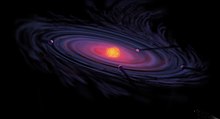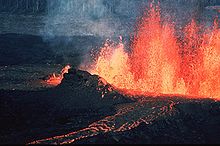Evolution of the earth's atmosphere
The evolution of the earth's atmosphere is part of the theory of the chemical evolution of the earth and also an important element of climate history . Today there are four main stages of development.
Basics
There is no binding model for dividing the development of the earth's atmosphere into four levels and the language used is very different. The first stage is quite uniformly called the primordial atmosphere , primordial atmosphere or first atmosphere . Depending on the choice of terms , all the following stages of development are numbered, either by continuing with the first atmosphere or by using the expression first atmosphere as a synonym for the primordial atmosphere and consequently the second atmosphere follows. The first alternative is used below. It should be noted, however, that in the case of coarser classifications, the state of the atmosphere is referred to as the primordial atmosphere until higher oxygen concentrations occur .
There were fluctuations in the concentrations of atmospheric gases regardless of a division into certain stages of development throughout the history of the earth . Today's atmosphere is no exception, and its composition is therefore also changeable within the framework of human time scales. The atmosphere is in constant interaction with the other earth spheres , especially the hydrosphere with its oceans and the lithosphere above volcanism . But also the soil and especially the living world are influences that should not be underestimated. Ultimately, only the interaction of all factors, including their numerous interaction mechanisms, can provide a conclusive explanation of how the atmosphere developed in the past ( paleoclimatology ) and possibly will develop in the future ( climatology ).
development
Primordial atmosphere

The earth was formed 4.58 billion years ago. Very early on, it had a gas envelope, presumably composed of hydrogen (H 2 ) and helium (He) and, to a lesser extent, methane (CH 4 ), ammonia (NH 3 ) and some noble gases , which, however, only right because of the lower gravitational field was weakly bound to the planet. As a result, it was almost completely lost again within a few hundred million years. This was due to the contraction-related warming, the decay of radionuclides with the release of heat and the frequent impacts of smaller celestial bodies , which, due to the very high speeds of the impacting objects, led to - at least partially - melting of the earth. At this very high temperature, which due to the high particle speeds (see atmosphere ) alone would have been enough to dissolve the earth's early gas envelope, came the ignition of nuclear fusion in the sun . The extremely strong solar wind that then set in also removed the last remains of the primordial atmosphere, especially the light elements, and blew them into the outer areas of the solar system . From spectral analyzes of the planets there, especially Jupiter and Saturn , a large part of the scientific theories regarding the early earth's atmosphere comes from.
First atmosphere

Over time, the impacts became rarer and their intensities continued to decrease. In this way, the earth was able to cool down slowly by emitting thermal radiation into space. The lower temperatures and thus particle speeds of the gases reduced diffusion into space, which promoted the creation of an atmosphere. The subsequent volcanism led to strong outgassing and thus created the first atmosphere. The gravitational differentiation of the earth, in particular the formation of an iron-nickel core, had a dramatic effect on the composition of these emissions. As a result, the earth's crust and mantle showed a much higher degree of oxidation and as a result mainly released carbon dioxide, nitrogen and sulfur dioxide, but less methane, hydrogen sulphide and ammonia.
A little over four billion years ago, the atmosphere at that time probably consisted of around 80% water vapor (H 2 O), 10% carbon dioxide (CO 2 ) and 5 to 7% hydrogen sulfide (H 2 S) as well as traces of nitrogen (N 2 ), hydrogen (H 2 ), carbon monoxide (CO), helium, methane and ammonia. These are the very products of volcanism that can also be observed in today's volcanism. Otherwise this information cannot be proven directly. The high proportion of water vapor can be explained by the fact that the atmosphere at that time was still too warm to be able to form precipitation . So there were no bodies of water on earth. The origin of the water is disputed.
Second atmosphere
After the earth had cooled down sufficiently, there was an extremely long continuous rain of about 40,000 years, after which the oceans had formed and the other atmospheric gases were accordingly enriched relative to the water vapor. The high levels of UV radiation caused a photochemical breakdown of the water, methane and ammonia molecules, which caused carbon dioxide and nitrogen to accumulate, possibly including tholine . Early metabolic processes of fermenting and chemolithotrophic bacteria and archaea also increased the content of nitrogen and methane. The light gases such as hydrogen or helium evaporated into space, especially carbon dioxide and hydrogen sulfide were dissolved in large quantities in the newly formed oceans. Carbon dioxide forms in solution in water carbonic acid (H 2 CO 3 ), from which by dissociation of bicarbonate ions (HCO 3 - ,) carbonate ions (CO 3 2- ) and hydrogen ions (H + accurate) (: oxonium - Ions H 3 O + ). As a result, the hydrogen ion concentration was high and the pH value was very low. Carbonate ions form sparingly soluble carbonates with certain cations , especially calcium ions, which are precipitated. Due to the low pH value, however, the concentration of carbonate ions was very low, and calcium carbonates did not initially precipitate. The consumption of carbon dioxide to build up biomass, i.e. for the growth of living beings, increased the pH value and thus also the concentration of carbonate ions, with the result that carbonates were precipitated. This led to massive deposits on the ocean floor. Only the inert nitrogen remained unaffected. This accumulated over time, and about 3.4 billion years ago the development of the second atmosphere was completed. It now presumably had nitrogen as its main constituent and, in smaller quantities, probably contained water vapor, carbon dioxide and argon.
Third atmosphere
The formation of oxygen (Dioxygen, O 2 ) plays the main role in the formation of today's third atmosphere. Here comes oxygenic photosynthesis a dominant position to other effects, such as the photo-dissociation of water vapor, are almost negligible. Although the cyanobacteria were the first organisms to carry out oxygenic photosynthesis, perhaps 3.5 billion years ago, their effect on the composition of the earth's atmosphere became apparent very late. The reason for the initially low enrichment of free oxygen was that the oxygen formed in the oceans reacted immediately chemically with other substances in its environment.
Oxygen was consumed in the oxidation of divalent iron to trivalent iron, i.e. the formation of Fe (III) compounds that are difficult to dissolve in water, and in the oxidation of hydrogen sulfide or sulfide to sulfate. As the oxygen was consequently unable to accumulate in the oceans, no oxygen was initially released into the atmosphere. Sulphidic heavy metal minerals were also oxidized, for example FeS and FeS 2 to Fe 2 O 3 and SO 4 2− . The ribbon ores still give evidence of this stage in the history of the earth.
After all, due to the drop in iron (II) and sulphide concentrations around 2.3 billion years ago , the oxygen , mainly produced by cyanobacteria and algae , was enriched in the oceans and thus also escaped into the atmosphere. The oxygen concentration in the atmosphere rose to around 3% by 1 billion years ago. At the same time, the concentration of carbon dioxide decreased as a result of its assimilation by living things and the precipitation of carbonates. The first aerobic organisms appeared 1.5 billion years ago. They used oxygen in an oxidative energy metabolism and thus gained more energy (in the respiratory chain ) than in an energy metabolism without oxygen. Oxygen-consuming respiration and oxygen-forming photosynthesis ultimately achieved a balance.
The increasing oxygen concentration led to the formation of ozone (O 3 ) in higher layers of the atmosphere around 750 to 400 million years ago and thus to a shielding of the earth's surface from UV rays, which is a decisive role for the development of life on the continents played. 500 to 600 million years ago the oxygen sinks were saturated and the oxygen concentration in the air rose sharply to 12% due to oxygenic photosynthesis. The current level was first reached about 350 million years ago, but has seen several strong fluctuations since then. The oxygen content during the Carboniferous was over 30% and fell to around half as a result of climate change during the Permian-Triassic transition . By the Jura , the oxygen content rose again to 26% , not least because of the development of trees , reached a new peak in the Cretaceous period at 30% and then gradually fell to today's level of around 21%.
Recent development
Most recently, there has been an increase in the concentration of greenhouse gases . In particular, the concentration of carbon dioxide in the earth's atmosphere has increased by almost half over the past hundred years. However, it is not only the total concentration of a gas over the entire atmosphere that is important, but also the stratification (gradient) . For example, ozone in the ozonosphere is of great importance for life in rural areas, but it is harmful to health in the lower troposphere ( smog ).
literature
- David C. Catling, Mark W. Claire: How Earth's atmosphere evolved to an oxic state: A status report . Earth and Planetary Science Letters 237, 2005, pp. 1-20, doi : 10.1016 / j.epsl.2005.06.013 , ( online ; Engl.).
- Heinrich D. Holland: The oxygenation of the atmosphere and oceans . In: Phil. Trans. R. Soc., B. Vol. 361, 2006, pp. 903-915, doi : 10.1098 / rstb.2006.1838 , ( online ; Engl.).
- GH Shaw: Earth's atmosphere - Hadean to early Proterozoic . In: Chemistry of the Earth . Vol. 68, No. 3, 2008, pp. 235-264 (Eng.).
Individual evidence
- ↑ Wiki.Bildungsserver.de: History of the earth's atmosphere
- ^ Karl-Heinz Ludwig: A short history of the climate , pp. 14-15, Verlag CH Beck
- ↑ TU Darmstadt , Department of Meteorology: First Atmosphere - here called the Primordial Atmosphere ( Memento of the original from November 14, 2016 in the Internet Archive ) Info: The archive link was automatically inserted and not yet checked. Please check the original and archive link according to the instructions and then remove this notice. .
- ↑ TU Darmstadt , Department of Meteorology: Chapter 1.2: Formation of today's atmosphere ( Memento of the original from November 14, 2016 in the Internet Archive ) Info: The archive link has been inserted automatically and has not yet been checked. Please check the original and archive link according to the instructions and then remove this notice. . Retrieved Jan / 2017.
- ↑ Oxygen content-1000mj
